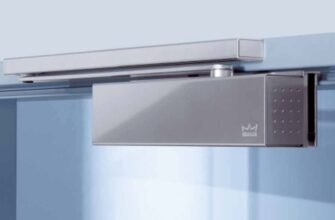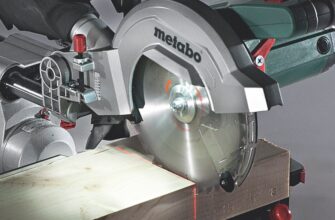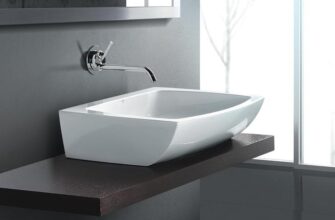Any repair work, regardless of their nature, very often ends with painting work, the quality of which greatly affects the appearance and perception of the work done. There are a great many ways to apply paint and varnish: you can apply paint in the old-fashioned way with a brush or a roller, you can use a compressor and a special nozzle used by auto painters for this purpose. Or you can resort to using a spray gun – a compact device that ensures uniform paint application and allows you to achieve the maximum quality of painting work.

- The best manufacturers of spray guns – which company to choose
- The device and principle of operation of the spray gun
- Types of spray guns
- Mechanical spray guns
- Advantages
- disadvantages
- Advantages
- disadvantages
- Electric Air Spray Guns
- Advantages
- disadvantages
- Advantages
- disadvantages
- Advantages
- disadvantages
- Device power
- Dispensed peak pressure
- Which spray gun to choose?
- Cost of spray guns
The best manufacturers of spray guns – which company to choose
It's no secret that the best equipment for painting work is professional, often highly specialized models that have received many positive reviews from masters in this field. Products from the following manufacturers can be recommended for purchase:
-
Makita
-
Wagner
-
Bosch
-
Devibiss
Before giving preference to this or that spray gun model, you should carefully familiarize yourself with the range of models presented in the catalogs, as well as study the reviews of people who managed to test a particular model in business and formed their own opinion about it.
The device and principle of operation of the spray gun
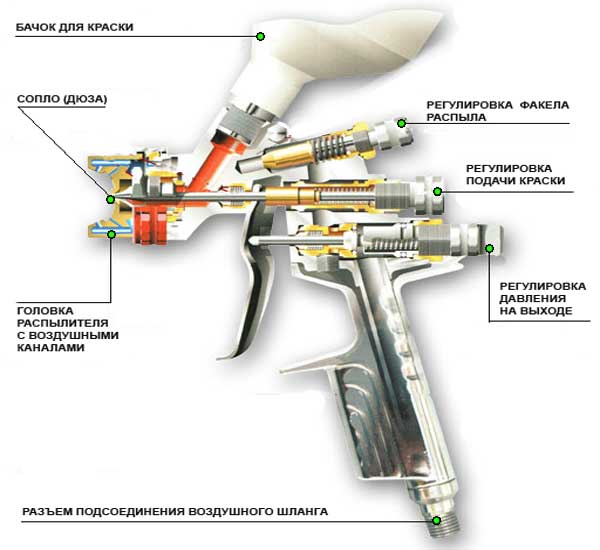
The principle of operation of any spray gun is based on a uniform spraying of paints and varnishes in the form of a continuous fountain of splashes. For this purpose, the design provides two independent channels: the first is responsible for the supply of air under pressure, the second, blocked by a needle, supplies paint. When the trigger is pulled, air is first supplied, and only then – paint. As a result, the paint mixes with the air mass and is fed out in the form of a so-called torch, laying down in a uniform layer, free from subsidence, sagging and smudges.
-
The design includes the following main components and assemblies:
-
Spray;
-
Tank for paint and varnish composition;
-
Initial pressure regulating unit;
-
Filter element for paint and a special nozzle for its uniform supply;
In addition to the above nodes, for the full functioning of the spray gun, you may need to connect an external compressor or an electric pump.
Types of spray guns
Mechanical spray guns
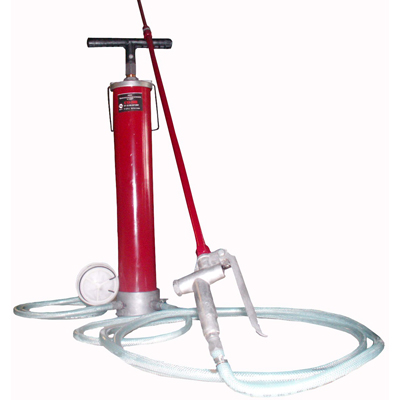
The simplest devices that are not particularly complex in design and are unable to produce an excessively high quality of painting, however, are more than suitable for household needs and general construction work. The use of such models does not require any special devices – the air pressure is pumped into the tank using a simple hand pump, and when a pressure of about 1/2 MPa is reached, a check valve that supplies paint is triggered.
Advantages
-
Simple and unpretentious design;
-
Low cost;
-
Perfect for general construction work;
-
Do not require special skills during operation;
disadvantages
-
Quite mediocre paint quality – not suitable for automotive work;
-
The need to constantly pump air manually;
Pneumatic spray guns
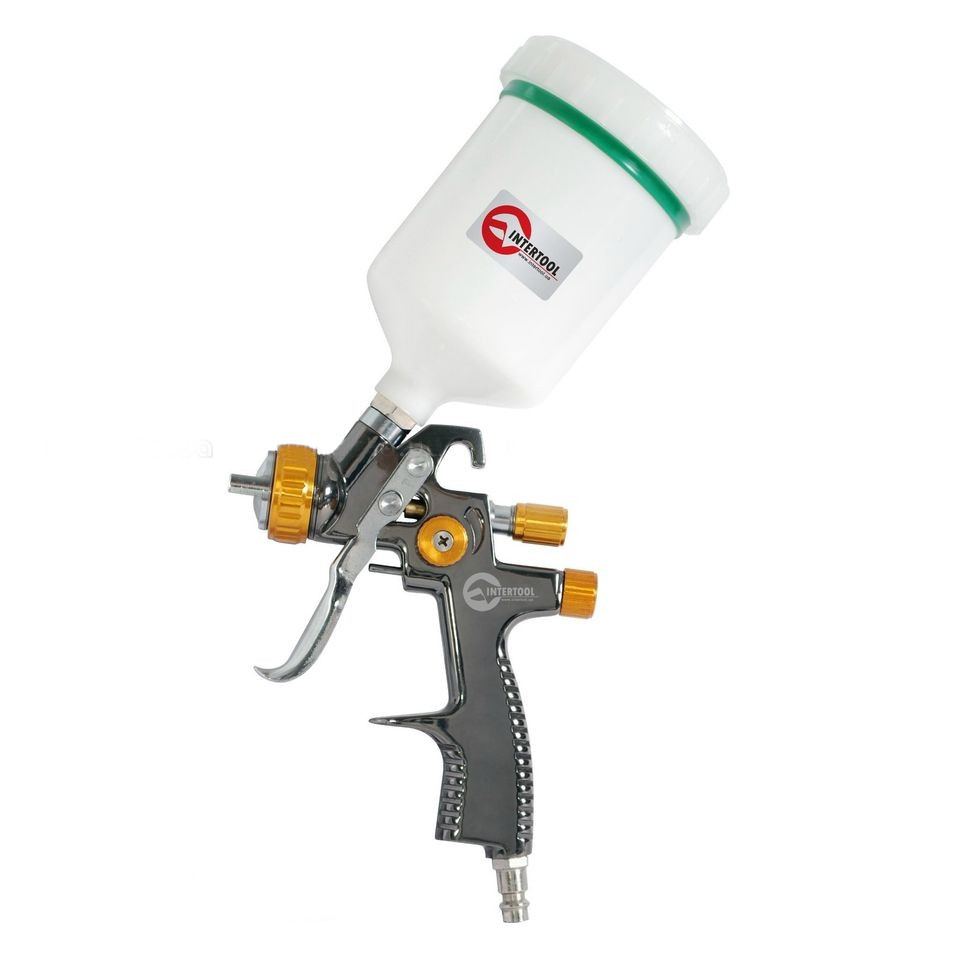
The most common devices in our time. Simple and easy to use. All mechanical work is performed by a compressor, which pumps air into the reservoir. They are able to give high quality painting, and are also very economical – the degree of transfer of the emulsion to the painted surface reaches 75-80%. As a rule, they are almost always made of lightweight metals that are not subject to corrosion, and therefore are very convenient, functional and durable.
Advantages
-
Easy to operate;
-
High degree of transfer of emulsion to painted parts;
-
Provide high quality painting;
-
Comfortable and durable;
disadvantages
-
High price;
-
The need to connect a compressor for operation;
Electric Air Spray Guns
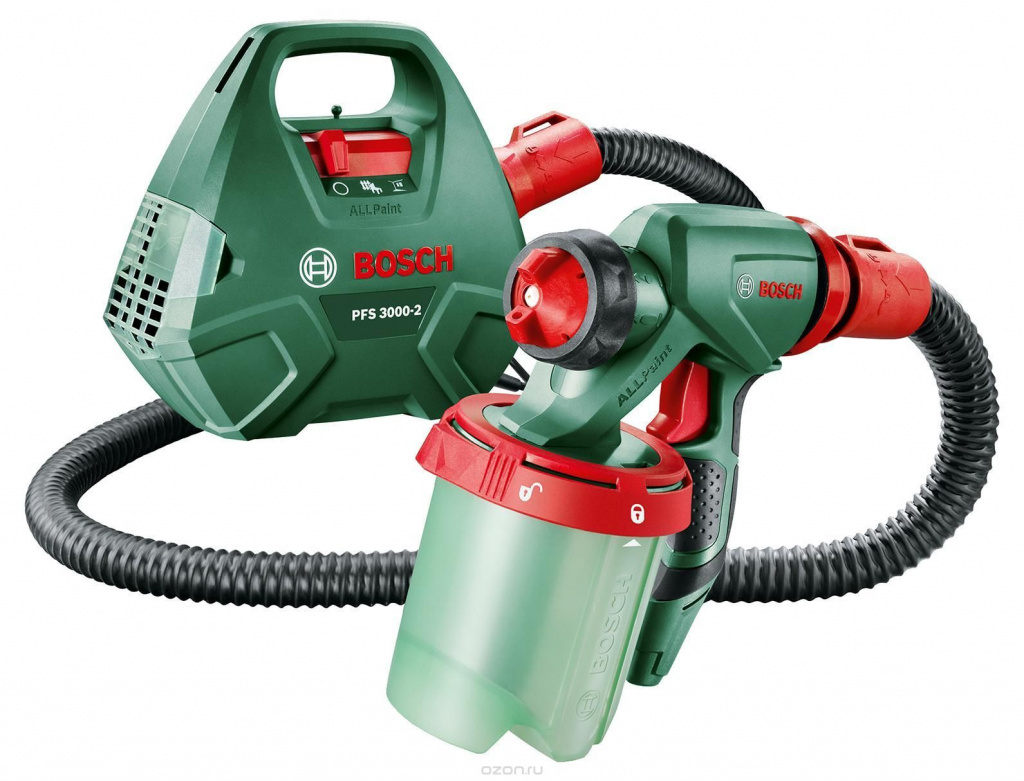
Unlike the models described above, air is injected here using an electric pump, which makes electric spray guns quite compact and easy to use. These devices work from a conventional 220 Volt outlet, are unpretentious in care and maintenance, which makes them extremely popular devices in everyday life.
Advantages
-
Compact dimensions and low weight;
-
Low cost;
-
High performance of the device;
-
Convenient, reliable design;
disadvantages
-
The quality of painting is lower than that of pneumatic devices;
-
'Binding' to the electrical network;
-
Noisy operation of the electric pump;
Electric Airless Spray Guns
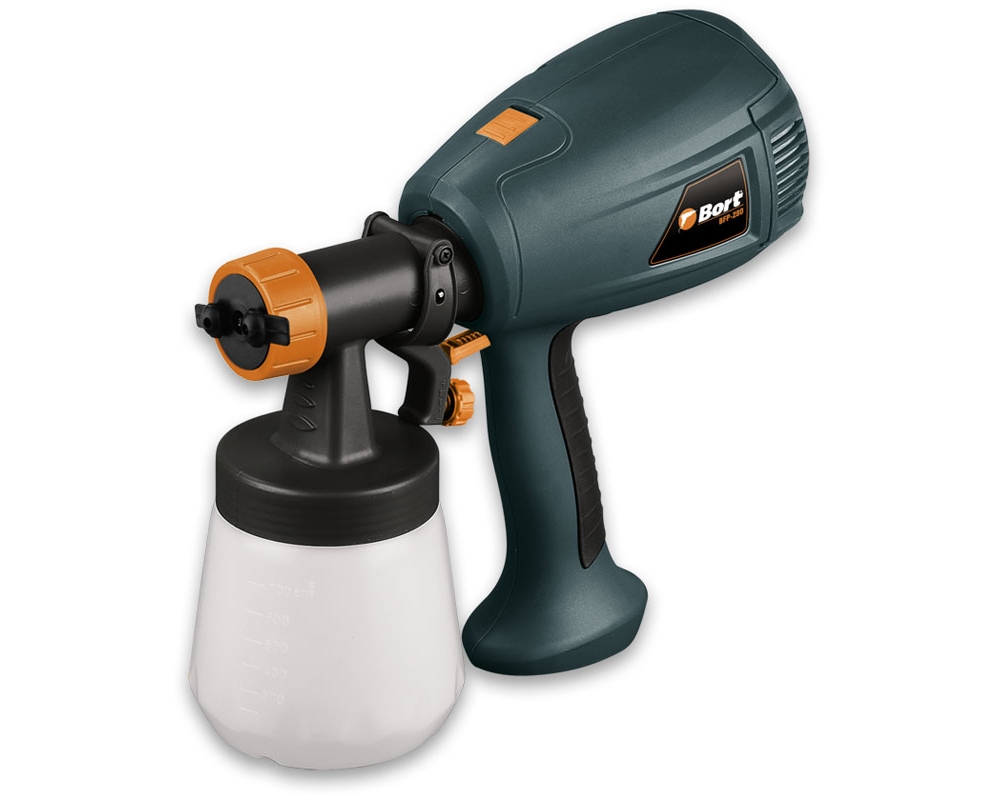
The specifics of the operation of this type of device are in many ways similar to the above models, however, there is a significant difference in them. These models do not have a high boost pressure, and a separate device – a plunger – is responsible for supplying the air mixture. Thanks to it, paint consumption is significantly reduced. These are compact, miniature devices, convenient in everyday use both in the apartment and in the summer cottage. Another undoubted advantage is the fact that the plunger suction system eliminates the need for a reservoir and sucks paint directly from the bucket.
Advantages
-
Compact size, light weight;
-
Democratic price tag;
-
Very low paint consumption during operation;
-
Unpretentious in care and cleaning;
disadvantages
-
Quite mediocre painting quality;
-
Not suitable for use with all types of paints and varnishes, many manufacturers recommend using only with synthetic and acrylic paints;
Cordless spray guns
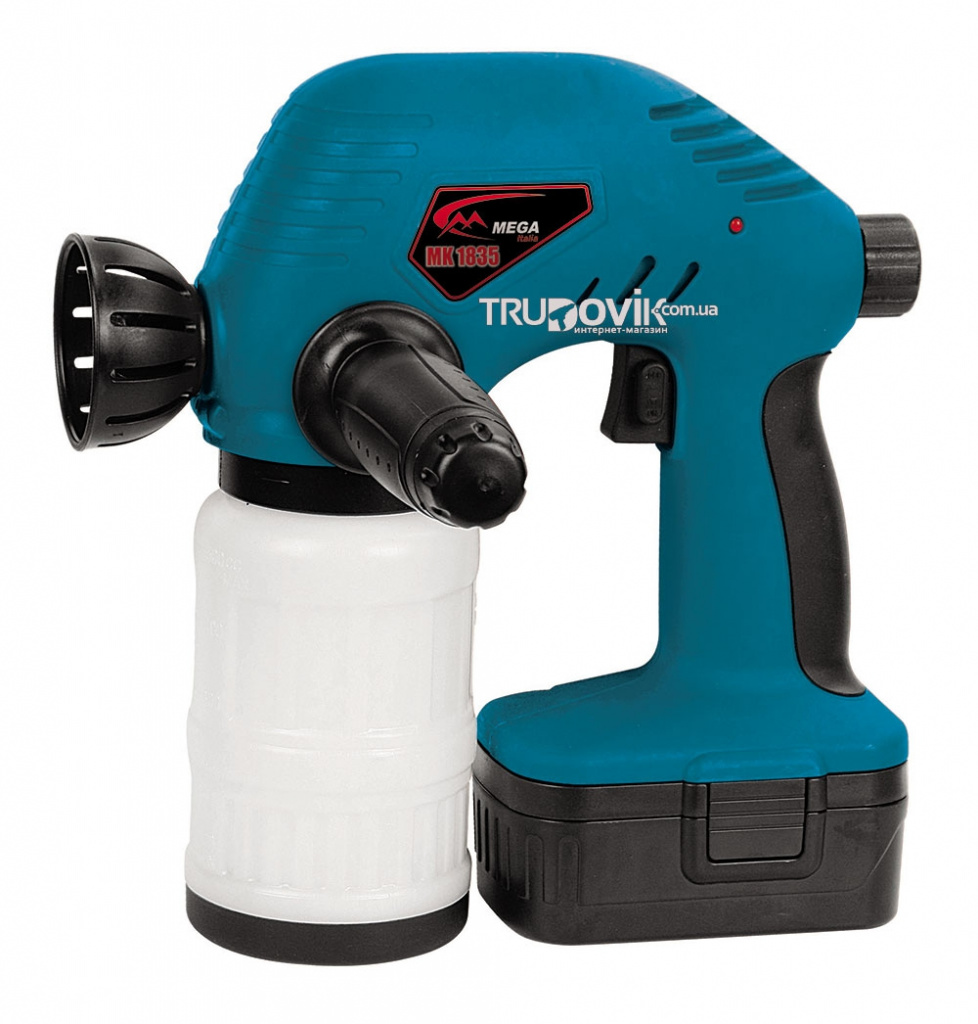
The most miniature and easy-to-use devices, the appearance of which resembles a classic screwdriver. According to their principle of operation, these devices are not much different from ordinary electric spray guns, only a different power source – in these devices, a compact battery plays its role. This feature makes it very compact and mobile – you can work with the device even where there is no outlet. Add to this a small consumption of paint and its very high-quality styling – and you will see, perhaps, one of the best devices in its class.
Advantages
-
Smallest dimensions and lightest weight;
-
They are extremely convenient and do not require special skills during operation;
-
Independence from external power supplies;
disadvantages
-
Low battery life;
-
Relatively mediocre painting quality (when compared with pneumatic models);
Spray gun selection parameters
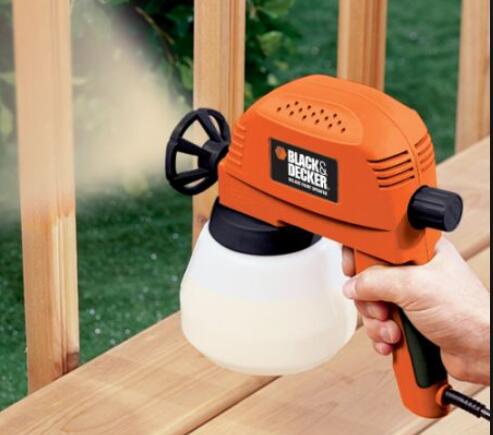
In addition to the design and principle of operation, there are a number of criteria that you need to pay attention to when choosing a spray gun.
Device power
-
Devices with power up to 450-500 W are classified as low-power and are recommended for use in domestic conditions. Such devices are demanding on the composition of the paintwork and are poorly 'friendly' with thick, weakly diluted compositions.
-
Spray guns with a power exceeding 500 W can be classified as professional equipment. They easily cope with any type of paintwork and give a high-quality, uniform coating at the output. There is only one drawback for such devices – a high price;
-
Separately, mention should be made of pneumatic spray guns, the power for which is a minor parameter, entirely depending on which compressor this or that device is connected to. In general, it can be noted that the power range of pneumatic spray guns varies between 0.5 – 2 kW.
Dispensed peak pressure
-
Low-power devices (up to 1.5-2 atmospheres). Household appliances that give the quality of painting of a low level;
-
Medium power devices (2-4 atmospheres). They are considered the golden mean among painters – the ratio 'painting quality \ consumption of paints and varnishes' for these models can be considered optimal;
-
High power spray guns (over 4 atmospheres). Professional devices used by car painters. Allows to ensure the maximum quality of painting. The price for it is a high consumption of paints and varnishes.
Which spray gun to choose?

-
For home use and carrying out one-time painting works that do not require a perfectly uniform and high-quality paint layer, simple mechanical spray guns are perfect;
-
If you are faced with the need for painting work regularly, and the quality of paint application is critical for you, you should pay attention to electric spray guns. These devices are compact and mobile, they are powered from a regular household outlet and do not require the purchase of additional equipment;
-
In the case when painting is your main source of income, and the quality of the applied coating is the main criterion for you, you should choose pneumatic spray guns.
Cost of spray guns
Cost is an extremely variable value, directly dependent on what type of device belongs to:
-
The cheapest are mechanical spray guns. Their price tag starts from 600-700 rubles;
-
The cost of classic electric spray guns and their plunger counterparts is at a comparable level – from 2,000 to 6,000 rubles;
-
Cordless spray guns, in view of the possibilities they give to the painter, are much more expensive – their price tag varies around 10 thousand rubles;
-
The most expensive are professional pneumatic spray guns. From what functionality this or that device has, its price also varies. The cost can reach 40-50 thousand rubles.
In the following articles, our experts will tell you how to choose a grass trimmer and the secrets to choosing an electric planer.
Attention! This material is the subjective opinion of the authors of the project and is not a purchase guide.



